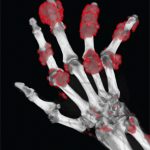In summary, it is likely that the pharmacokinetics of pegloticase rather than the genetic profile of urate transporters played an important determinant in the success of pegloticase therapy reported in the case reported by Dr. Girnita. Because the mechanism of pegloticase involves metabolizing uric acid to soluble products largely in the circulation regardless of the reason it is elevated, it is difficult to imagine how the mechanism of urate elevation would be a determinant of its effectiveness. However, the capacity to degrade urate is directly related to its presence and concentration in the circulation, and factors that affect those parameters, including anti-drug antibodies of sufficient titer (>1:2430) and characteristics of the subject, such as body mass and volume of distribution, will certainly have an effect.
In rare subjects, such as the one described by Dr. Girnita, who fail to lower their urate two weeks after the first dose, more frequent urate monitoring might be considered, as well as more frequent dosing as is currently being tested in the Tolerization Reduces Intolerance to Pegloticase and Prolongs the Urate Lowering Effect (TRIPLE) protocol (NCT 02598596).
Sincerely,
Peter E. Lipsky, MD
Anthony Yeo, MBBS, PhD, MPH
Reference
- Lipsky PE, Calabrese LH, Kavanaugh A, et al. Pegloticase immunogenicity: The relationship between efficacy and antibody development in patients treated for refractory chronic gout. Arthritis Res Therapy. 2014 Mar 4;16(2):R60.
The authors reply: We appreciate the interest shown by Dr. Lipsky and Dr. Yeo in our case and are grateful for their insight into our patient’s case.
Our patient had a BMI of 37, and it appears that he might be consistent with the two individual failures reported by Lipsky et al. Pegloticase levels were not measured in our patient post infusion and uric acid levels were not checked 24 hours post infusion. Thus, based on the current information, we cannot confirm whether altered pharmacokinetics due to obesity played a role in our patient’s suboptimal response. So this remains a speculative, yet quite likely explanation.
We eagerly await the completion and results from the TRIPLE study (NCT 02598596) to guide us with regard to the dosing intervals in similar patients. If the relationship between BMI and drug efficacy is found to be true, this will significantly impact the dosing regimen, especially with the current high prevalence of obesity.
—Diana M. Girnita, MD, PhD, Cody Lee, MD, & Christine Chhakchhuak, MD


